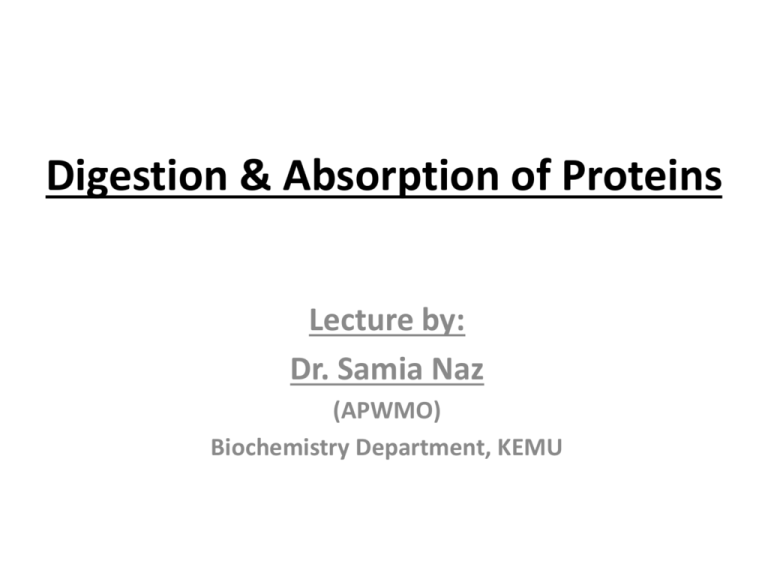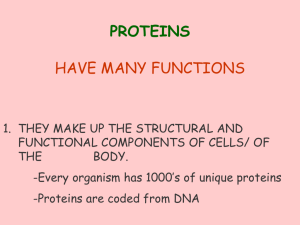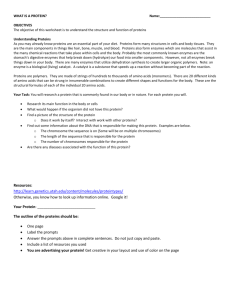Digestion & Absorption of Proteins – Lecture by Dr Samia Naz
advertisement

Digestion & Absorption of Proteins Lecture by: Dr. Samia Naz (APWMO) Biochemistry Department, KEMU Introduction • Proteins are the primary constituents of body. • These are genetically designed sequences of amino acids linked together by peptide bonds. • Amino acids are used for synthesis of body proteins and to yield energy 4.1kcal/gm by oxidation. • Proteins are nitrogenous macromolecules. Digestion of Dietary Proteins • Process of breaking down ingested food material into easily absorbed and assimilated substances by mechanical and enzymatic action in alimentary canal. Dietary proteins are hydrolyzed to amino acids by proteolytic enzymes which can be easily absorbed. • Proteolytic enzymes, degrading the proteins are present in stomach, pancreas and small intestine. Proteolytic enzymes in GIT • Gastric enzymes • Pancreatic enzymes • pepsin renin Endopeptidases -Trypsin - Chymotrypsin - Elastase Exopeptidases - Carboxypeptidase - Collagenase • Enzymes of epithelial cells • Enzymes within enterocytes A B Exopeptidases - Aminopolypeptidase - Tripeptidase - Prolinase Intracellular peptidases Digestion in mouth No digestion in mouth, no proteolytic enzymes, after mastication and chewing bolus is formed which enters the stomach. Digestion in stomach • Digestion of proteins start in stomach. • When proteins enters the stomach it stimulates the secretion of the hormone gastrin, from gastric mucosal cell. • This gastrin, in turn, stimulates the release of gastric juice, which contains • Hydrochloric acid:- denatures proteins, decreases pH(pH 2-3), activates pepsinogen • Pepsinogen: Zymogen secreted by chief cells, activated to pepsin by HCl and autocatalysis. • Pepsinogen pepsin Pepsin breaks the peptide bonds of a) b) c) aromatic amino acids (phenylalanine, tyrosine, tryptophan) acidic amino acids (glutamic acid, aspartic acid) pepsin hydrolysis proteins into polypeptides and free amino acids Rennin in infants • Active in infants • Causes curdling of milk, converts casein of milk into paracasein, combines with calcium to form calcium paracaseinate • Absent in adult stomach Pancreatic enzymes The bolus of food after leaving the stomach reaches duodenum and is acted upon by the pancreatic juice. All the enzymes are active only in alkaline medium and alkalinity is avoided by bile and bicarbonate present in pancreatic juice. The release of pancreatic zymogens is mediated by the secretion of cholecystokinin and secretin, two polypeptide hormones of digestive tract. Endopeptidases 1. Trypsin occurs as trypsinogen Trypsinogen Enteropeptidase Trypsin 2. Chymotrypsin occurs as chymotrypsinogen Chymotrypsinogen trypsin chymotrypsin – Both enzymes act on centrally situated peptide bonds at pH 8 – Protein molecules are hydrolyzed to polypeptides of various length. 3. Elastase occurs as Pro elastase Pro elastase trypsin elastase Exopeptidase 1. Carboxypeptidases A :• Acts on carboxyl end peptide bond Procarboxypeptidase A trypsin carboxypeptidases A 2. Carboxypeptidase B: • Acts on carboxyl end peptide bond Procarboxypeptidase B trypsin 3. Collagenase pro collagen collagenase collagen carboxypeptidases B Digestion at the mucosal surface of epithelial cells of small intestine(Enterocyte) • Exopeptidases : a) Amino polypeptide acts on the peptide bond on amino terminal of amino acids . b) Tripeptidases and Dipeptidases. hydrolyse tripeptides and dipeptides to their individual amino acids. c) Prolinase hydrolyses small peptides having proline at terminal amino acids. These enzymes act on their substrates which have entered brush border of enterocytes. Digestion within Enterocytes • Intra-cellular peptidases hydrolyze dipeptides, tripeptides and oligopeptides within brush borders of enterocytes which are completely absorbed. • Sodium-Amino acid carrier system it transports proteins with Na ions and amino acids by Na-K by ATPase activity Basolateral Membrane • Transport of free amino acids into portal system. Peptides are hydrolyzed within the enterocyte • Transport mainly by diffusion and active transport Absorption of Intact Proteins • Newborns First 24 hours after birth Immunoglobulins Passive immunity • Adults Paracellular routes • Tight junctions between cells Intracellular roites • Endocytosis • Pinocytosis • Of little nutritional significance… Affects health (allergies and passive immunity)








